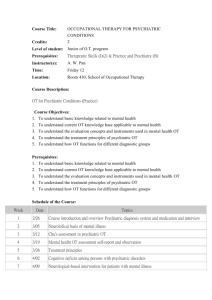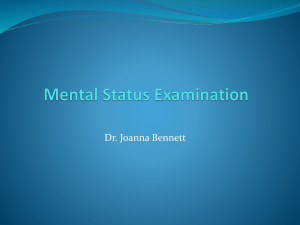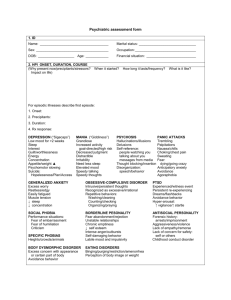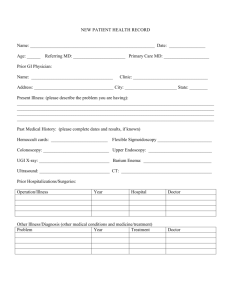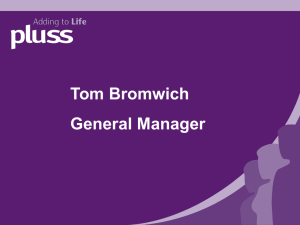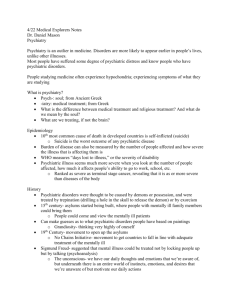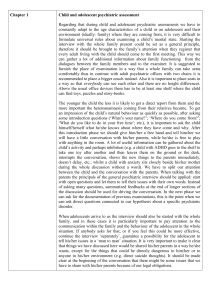The MSE: Details and Neural Basis - Vanderbilt University School of
advertisement
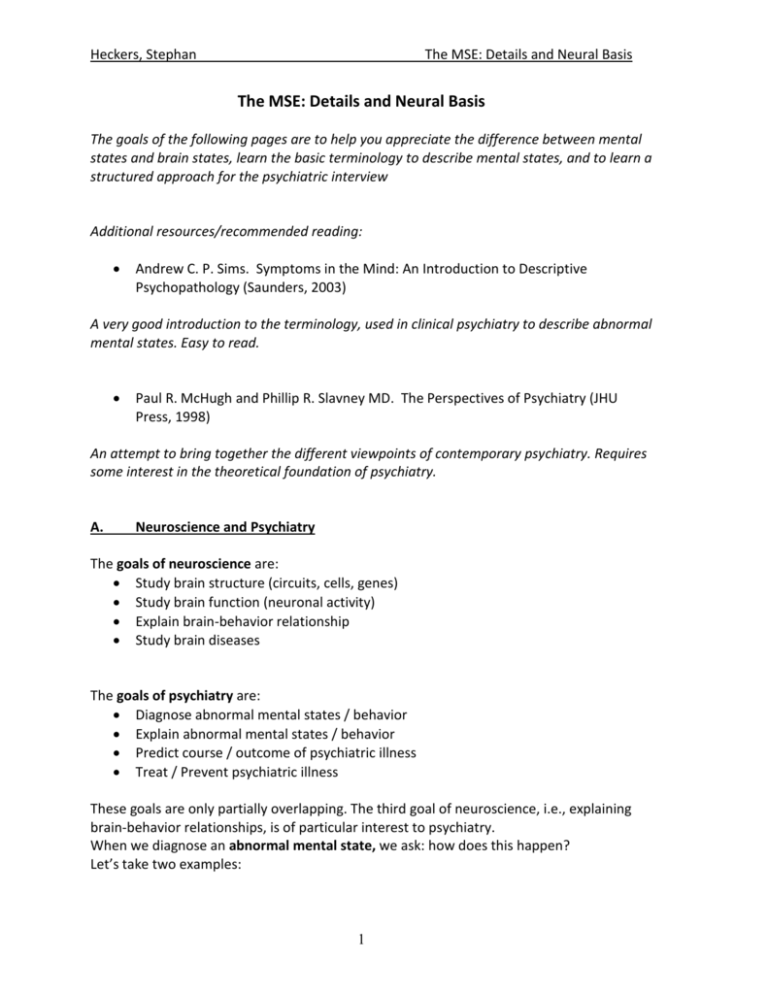
Heckers, Stephan The MSE: Details and Neural Basis The MSE: Details and Neural Basis The goals of the following pages are to help you appreciate the difference between mental states and brain states, learn the basic terminology to describe mental states, and to learn a structured approach for the psychiatric interview Additional resources/recommended reading: • Andrew C. P. Sims. Symptoms in the Mind: An Introduction to Descriptive Psychopathology (Saunders, 2003) A very good introduction to the terminology, used in clinical psychiatry to describe abnormal mental states. Easy to read. • Paul R. McHugh and Phillip R. Slavney MD. The Perspectives of Psychiatry (JHU Press, 1998) An attempt to bring together the different viewpoints of contemporary psychiatry. Requires some interest in the theoretical foundation of psychiatry. A. Neuroscience and Psychiatry The goals of neuroscience are: • Study brain structure (circuits, cells, genes) • Study brain function (neuronal activity) • Explain brain-behavior relationship • Study brain diseases The goals of psychiatry are: • Diagnose abnormal mental states / behavior • Explain abnormal mental states / behavior • Predict course / outcome of psychiatric illness • Treat / Prevent psychiatric illness These goals are only partially overlapping. The third goal of neuroscience, i.e., explaining brain-behavior relationships, is of particular interest to psychiatry. When we diagnose an abnormal mental state, we ask: how does this happen? Let’s take two examples: 1 Heckers, Stephan The MSE: Details and Neural Basis (1) A man believes that his actions are being controlled by aliens and that his thoughts are being broadcast to others, who then read his mind. (2) A woman has become increasingly depressed and engages in self-injurious behavior. What is the mechanism of these abnormal mental states? How can we treat these condition? – which is especially relevant if the abnormal mental state leads to behavior that poses risks to the person or to others. How can we make sense of a person’s behavior? As a physician, you will be exposed to such clinical scenarios many times and you will try to explain such mental states and behavior to others. The approach of neuroscience is the reduction of complex phenomena (mental state, human behavior) to processes at the level of neural networks (e.g., cortex, basal ganglia, hippocam-pus – you will learn about them), nerve cells, and components of individual cells (primarily receptor proteins and genes governing their function). While there is no reason to doubt that this approach will be largely successful, there is still a considerable gap in our knowledge of the brain and our scientific understanding of human behavior. B. Making progress: The success story of Alzheimer’s Disease research In 1901, the German psychiatrist and neuropathologist Alois Alzheimer (1864–1915) observed Mrs. Auguste Deter, a patient at an asylum where he worked. The 51year-old patient behaved strangely and had prominent cognitive deficits, including a loss of short-term memory. In April 1906, she died and Alzheimer obtained the patient records and the brain. More by serendipity than by plan, he would use a novel staining technique to identify plaques and neurofibrillary tangles. What Alzheimer was able to do has remained the exception in psychiatry: he linked an abnormal mental state / behavior to an abnormality in the brain. It took more than seventy years for the next major step in unraveling the mechanism of Alzheimer’s Disease – the discovery that the plaques are depositions of the betaamyloid protein. Once this discovery was made, it took only 3 more years to find rare, familial cases of Alzheimer’s disease, where the beta-amyloid pathology could be linked to mutations in the gene coding for beta-amyloid, located on chromosome 21. A second set of proteins, the presenilins, were found to be involved in Alzheimer’s disease as well and mutations for these proteins were found on chromosomes 1 and 14. 2 Heckers, Stephan The MSE: Details and Neural Basis The discovery of the molecular mechanism of Alzheimer’s Disease has led to large-scale efforts in academic medicine and the pharmaceutical industry to discover a drug that can stop or even prevent the disease process, by interfering with the abnormal processing of the proteins involved in Alzheimer’s Disease. Despite the great success at the level of genes, proteins and cells, we are still at a loss to explain the many clinical features of Alzheimer’s Disease. They include memory impairment, aphasia (language disturbance), apraxia (impaired ability to carry out motor activities despite intact motor function), agnosia (failure to recognize or identify objects despite intact sensory function) and disturbance in executive functioning (i.e., planning, organizing, sequencing, abstracting). This has left us in the strange position that we can now reliably diagnose Alzheimer’s disease and are on our way to find effective treatments, while being unable to explain the mechanism of the illness. C. The four main questions for psychiatry We will study four aspects of mental illness: clinical features, epidemiology, mechanism, and management. The four questions below will guide our review of anxiety, mood, psychotic, childhood and substance use disorders. What does mental illness feel / look like? (Clinical features of mental illness) We want to understand how the person feels, thinks, and relates to others. This makes the psychiatric encounter different from the objective study of physical signs and symptoms in medicine. It helps the clinician to be familiar with first-person accounts of mental illness (e.g., autobiographies and art work). During an interview, the clinician needs to be aware of one’s own feelings and thoughts, potentially leading to (positive or negative) biases in the interpretation. By the same token, the patient often projects her/his own feelings onto the clinician. When and how often does mental illness occur? (Epidemiology of mental illness) It is important to know the typical age of onset and the usual course and outcome of psychiatric disorders. Equally important is the awareness of genetic and environmental risk factors for the development of a psychiatric disorder. This information is not only relevant for researchers, but also for clinicians, as they formulate an assessment and make a prediction about disease course and outcome. Why and how does mental illness happen? (Mechanism of mental illness) At this point in time, this question is more important for the researcher than the clinician. But the clinician and the layperson use explanatory models to make sense of abnormal mental states and behavior. Popular notions such as “There is no mental illness, just personal weakness” or “All mental illnesses are brain disorders” shape our societal discourse, create biases and prejudice, and influence decision making about the allocation of resources for the study and treatment of mental illness. 3 Heckers, Stephan The MSE: Details and Neural Basis How do we manage mental illness? (Management of mental illness) While we are still searching for the scientific explanation of abnormal mental states and behavior, we have made dramatic progress in the management of many psychiatric disorders. Pharmacological modulation of neurotransmitters, the electrical stimulation of the brain and the thoughtful use of psychotherapy have all been of great benefit to the mentally ill. At the same time, each of these treatments is associated with adverse effects and need to be used thoughtfully. Four standard methods to explain mental disorder (from: Perspectives of psychiatry, McHugh and Slavney, 1998): • Disease (What the patient has: an identifiable abnormality) • Dimension (What the patient is: abnormal only in degree, not kind) • Behavior (What the patient does: learning and choosing) • Life story (What the patient wants: create meaning) 4 Heckers, Stephan D. The MSE: Details and Neural Basis The Psychiatric Interview A structured approach to mental phenomena is helpful in two ways. First, the diagnosis and treatment of the major psychiatric disorders relies on the accurate description of human behavior and mental states. When we review the major psychiatric disorders, you will benefit from this structure. Second, you will learn the psychiatric interview in small group sessions in the second half of the Brain & Behavior course and will appreciate this introduction. You will: 1. Learn the necessary terminology to describe normal and abnormal mental states. 2. Learn the basic approach to interviewing a psychiatric patient. 3. Learn the principles of the mental status examination. The basic question The most important question when conducting a psychiatric interview is: Why now? Why is a psychiatric interview necessary at this time? Is the person asking for help or is someone else (family member, friend, police) presenting the person for the interview? (Please bear this in mind when you interview patients during the Brain & Behavior course. Most patients will be inpatients who have consented to be interviewed.) The setting The office. This is a relaxed setting (the person is sitting in a chair or lying on a couch). Typically, there is little coercion and the person is looking for help. The clinic. This is still a voluntary setting, but more constrained. Patients have less privacy and often get less time with their care provider. The hospital. • The voluntarily admitted psychiatric patient. This is the best setting for successful treatment – the patient is usually motivated, cooperates with the interview and diagnostic process and adheres to the treatment plan. • The forcefully committed patient. This creates significantly different challenges, often requiring the evaluation of competency and the review of treatment options by a judge. • The medical or surgical patient who presents with psychiatric problems. This requires the integration of many medical and psychiatric data, often involving patients who are not able or not willing to provide much needed information. • The emergency room. Often acutely ill patients (intoxicated, agitated, delirious, suicidal) who need to be evaluated for the need of acute inpatient psychiatric care. Getting information The patient who talks. While the patient who is able and willing to engage in a conversation is more likely to provide relevant information, the interviewer needs to use caution when evaluating the completeness and accuracy of the data provided. Getting corroborating information from family members or other care providers is often essential to determine diagnoses and develop treatment plans. 5 Heckers, Stephan The MSE: Details and Neural Basis The patient who does not talk. There are different reasons why a person might not engage in a conversation. Some patients are not impaired in their ability to converse, but are not willing to engage. This could be due to many factors (e.g., personality, fear, anger directed against the interviewer) and the reason needs to be identified. Some patients are avolitional and do not engage in a conversation because of a psychiatric illness (e.g. mutism in a catatonic patient). Other patients are not able to engage in a conversation because of a language barrier, a sensory deficit or a neurological lesion. The approach Observation is an important aspect of the psychiatric interview. Many features of the mental status exam (see below) can be described by simple observation. Empathic assessment of subjective experience. It is this aspect that differentiates the psychiatric interview from the typical medical setting of taking a history and performing a medical examination. The insight-oriented interview aims to explain behavior (e.g., by uncovering unconscious conflicts). The symptom-oriented descriptive interview aims to classify behavior (e.g., observe signs and elicit symptoms) There are four components of the psychiatric interview (Othmer and Othmer, 2002) • Rapport (building a connection) • Technique (getting information) • Mental Status Exam (using a structured approach) • Diagnosing (translating the information into a diagnostic system) Phenomena of mental illness Signs: objective, observable Symptoms (1): subjective, based on report of patient Symptoms (2): reinterpretation of patient’s report Example Masked facies Decreased energy Delusion The psychiatric interview – A basic outline 1. Why now? – assess the situation 2. Put the patient and yourself at ease (Basic information, pronunciation of name, “Know a man’s dialect”) 3. Ensure safety for yourself and others 4. Start with open ended questions, move to more directed questions 5. Recognize and respond to signs 6. Recognize the suffering – show compassion 7. Assess insight and become an ally 8. Show expertise a. Use structured approaches b. Review medication and test results 9. Establish leadership a. Share diagnostic assessment b. Outline treatment plan 10. Be curious! Do not take anything for granted. 6 Heckers, Stephan E. The MSE: Details and Neural Basis Writing up the psychiatric interview (short version) Identifying information Sources of information / Reliability of sources Chief Complaint: “ …” History History of present illness Past psychiatric history Past medical history History of drug use Medication (current and past) History of adverse effects Social history Legal history Family history Exam Physical exam Neurological exam Mental Status Exam (MSE) Prior assessments and test results Formulation Diagnosis according to DSM IV Problem list Treatment and Management Plan 7 Heckers, Stephan The MSE: Details and Neural Basis WRITE-UP OF A PSYCHIATRIC INTERVIEW (A SIMPLE EXAMPLE) Patient: Date of birth: Date of Exam: A.B. 1/1/62 8/1/2007 Description: 45 year old, divorced white man, currently unemployed Sources of information Reliability of sources patient good Chief Complaint: “I am OK.” He is currently an inpatient s/p suicidal gesture History of present illness A.B. was brought to the psychiatric hospital 3 days ago via ambulance from his home (an apartment in town) after a neighbor found him on his front porch at 11 am, cutting his left forearm with a kitchen knife. The neighbor called the ambulance and the patient agreed to visit a local emergency room and then come to the psychiatric hospital. The cuts were superficial and did not require surgical attention. During the interview, the patient does not present with any complaints about the cuts. There are about 15 superficial wounds visible on his left forearm. When asked what made him cut himself, he states that he felt “I could not go on” and “it did not matter”. He states that he had not slept well for 5 nights and that he felt isolated after his girlfriend had been away for several weeks. He also mentions “I had one of my spells.” He recalls that he “could not breath” and that a feeling of anxiety came over him very quickly, lasting approximately 10-15 seconds. The patient acknowledges a recent history of depressed mood, low energy and decreased interest. He relates this to a “long battle” with his 40-year-old girlfriend. They were engaged and scheduled to marry later this year. He now feels abandoned by his girlfriend, who is spending increasingly more time with her own two children and other members of her family. The patient is also isolated from his ex-wife (they divorced 9 years ago) and their two children, a 22-year-old daughter and a 21-year-old son. He is not in touch with friends and has not engaged in his favorite activity, golf, for more than a year now. Past psychiatric history He denies any psychiatric history until 1994, when he was admitted to a psychiatric hospital. Known psychiatric hospitalizations 1) Hospital 1: 1994 and 2006 2) Hospital 2: 1998 and 2005 Known past outpatient treaters He is currently seeing a psychiatrist every 3 months for a 20-minute visit for psychopharmacological management of his mood symptoms. 8 Heckers, Stephan The MSE: Details and Neural Basis History of mood symptoms He reports several episodes of depressed mood, decreased energy, lack of interest, decreased sleep, poor concentration, and low appetite. The most significant depressive episode kept him in bed for 1 week and resulted in a 27 lbs weight loss over the course of several weeks. He recalls spending sprees of up to $18,000 in one setting (buying gold in Cancun, Mexico) and buying 2 cars when he already had one. This occurred during times when he felt very energetic and “high” (lasting about 2-3 weeks). He would drink excessively and would be more social, attending parties. However, he was able to function during these times and sometimes engaged in projects such as building a deck and a pool. He does not report a h/o psychotic symptoms during this time. He reports several suicidal gestures and suicide attempts. The most serious suicide attempt was a jump from a roof into a pool, during which he broke his ankle. He states that he was “tired of living” at that time. History of psychotic symptoms He denies any h/o hallucinations or delusions. History of other psychiatric symptoms He reports a h/o “OCD”. When asked to elaborate, he reports “counting things”, washing hands 15-20 times per day, checking that doors are locked (1-2 times), and a tendency to thrust his fist into his chest. He states that he has been treated with Zoloft 200 mg for relief of these obsessions and compulsive behaviors, with good success. He reports a long h/o alcohol dependence, including blackouts, delirium tremens, and DWI charges. He is now sober since 1999. Past medical history 1) s/p MVA at age 14 as a passenger in a head-on collision, resulting in LOC for 5 days and absence from school for 5 months. He reports significant facial injuries (requiring dentures at an early age) and walking difficulties for several years after the accident. History of drug use Drug 1 EtOH 2 Tobacco 3 MJ 5 Speed 6 Opiate, Tranquilizer Age of onset 16 17 17 18 no Dose / Last use 8/12/1999 1 ppd Used <5 times Used <5 times Effects relaxing calming calming Increased energy calming EtoH review Sober since August 1999. He reports h/o blackouts and delirium tremens. Endorses 4/4 on CAGE questionnaire. 9 Heckers, Stephan The MSE: Details and Neural Basis His favorite drinks have been beer and whiskey. Medication (all current medication + known past psychotropic medication) Drug class Drug Dose / Last use 5 Antidepressant Zoloft 200 mg qd 6 Benzodiazepine Clonazepam 0.5 mg tid 7 Augmentation Trazodone 200 mg qhs 11 ECT Never used Social history Born in a rural area of the state. Moved to another small city in the same state early on in his childhood and spent all his life there. He is the only child of an administrator (father) and a banking employee (mother). He describes his childhood as “happy” and recalls spending summers on his grandfather’s farm. He does not report any difficulties during his delivery and reached his developmental milestones (walking, talking, reading, writing) without problems. He attended and graduated on time from high school. After graduation, he worked in the insurance business for 16 years (until he became psychiatrically ill in the mid 1990’s). He was a salesman first and later was in charge of his own business, allowing him to enjoy a comfortable life with his wife and their two children. He has spent many hours on the golf course since early childhood and has remained passionate about the game. Legal history DWI x2, resulting in loosing his driver’s license (he currently holds one) Family history He denies a h/o mental illness in the family. Physical exam: N/A Neurological exam: N/A Mental status examination The patient is awake, alert and attentive. He is well groomed and displays normal hygiene. He is wearing jeans and a shirt. He keeps good eye contact during the interview and engages with the interviewer. He is friendly and cooperative and provides information readily. He is a good historian and a reliable source of information. His psychomotor activity is normal: he has a full range of motion, his movements are purposeful and of normal speed. His facial expression is of full range, breaking into a smile at times. He does not display any tics, stereotypies, or compulsions during the interview. His thought process is logical, coherent, and goal directed. There is no evidence of delusions. He denies any hallucinations. 10 Heckers, Stephan The MSE: Details and Neural Basis He describes his mood as “good”. His affect is full range, euthymic and appropriate. He denies any thoughts of suicide and he has not engaged in any suicidal gestures or acts since admission to the hospital. He states that he is willing and able to ask for help if he became more depressed and suicidal again. MMSE: 30/30 He is aware of his medical and psychiatric illnesses. He has good insight into the severity of his mood disorder and the importance of treatment. Assessments and test results Prior diagnoses: OCD, Bipolar Disorder, Depression Formulation A.B. is a 45 year old, divorced white man, currently unemployed, who is now an inpatient after a suicidal gesture three days prior to the interview. The circumstances leading to the recent suicidal gesture are not entirely clear, but are at least in part related to a deteriorating relationship to his fiancée. He also reports several signs of a depressive episode, similar to, but less pronounced than, previous depressive episodes in the last 10 years. The most striking feature of A.B.’s history is his relatively high level of functioning until 1994 and his significant struggle with mood and anxiety symptoms since then. It is not clear how much the MVA at age 14 and the long history of alcohol dependence contributed to this course of his psychiatric symptoms. Three sets of psychiatric symptoms were elicited during the interview: 1) significant periods of decreased as well as increased mood, including a recent episode of depression with a suicidal gesture 2) episodes of increased anxiety, including obsessions and compulsions, and 3) a strong history of alcohol dependence, now in sustained remission since 1999. While meeting criteria for mood, anxiety and substance-related disorders and despite a history of several suicide attempts, the patient has significant strengths, including good insight and judgment, intact cognitive skills, and an interest in hobbies. However, he has remained isolated in the recent past and he has not engaged in any meaningful employment for several years. A suicidal gesture brought him to the hospital, but he does not present with any thoughts about suicide now. The history of previous suicide attempts, the diagnosis of bipolar disorder, his age and gender, and significant social stressors are all risk factors for suicide and he needs to be evaluated, on a regular basis, for his ability to contract for safety. Diagnosis according to DSM IV Axis 1 1) Bipolar Disorder, type I, most recent episode depressed 2) Alcohol dependence, in sustained remission since 1999 3) r/o Obsessive-Compulsive Disorder versus Panic Disorder without agoraphobia Axis 2 none Axis 3 s/p MVA, resulting in CHI at age 14 Axis 4 Unemployment, Social isolation Axis 5 GAF: 20 at time of admission, now: 60 11 Heckers, Stephan The MSE: Details and Neural Basis Problem list 1) Suicidality 2) Mood disorder with depressive and manic symptoms 3) Anxiety disorder: Obsessive-compulsive disorder or Panic Disorder without agoraphobia Treatment and Management Plan Medication regimen • Review effectiveness of Zoloft. If he has failed this medication, switch to another antidepressant. • Start mood stabilizer. He has a h/o bipolar disorder and continues with depressed symptoms despite treatment with an antidepressants. Both are indications to treat him with a mood stabilizer. In addition, he is at risk for suicide attempts and mood stabilizers such as Lithium lower the risk for suicidal thoughts, gestures and attempts. • Review use of BZD for treatment of anxiety disorder, considering long h/o alcohol dependence. This decision should be made carefully, since he is at risk of relapse. Psychotherapy • Review previous trials and consider individual, couples, or group therapy. He is able to articulate his losses and feelings of abandonment. This makes him a good candidate for therapy, which would increase the chances of remission and relapse prevention. Occupational rehabilitation • Review recent employment history and current financial situation. These are significant social stressors, with a major impact on his ability to remain in remission. Refer for evaluation by employment agency 12 Heckers, Stephan The MSE: Details and Neural Basis Outline: The psychiatric interview (long version) (You may use this outline for your own interview.) Patient: Date of birth: Date of Exam: Name 00/00/0000 00/00/0000 Description: age, race, gender, relationship status, occupation Sources of information Reliability of sources Chief Complaint: “ …” (in the patient’s own words) History of present illness Onset of symptoms Nature (acute, insidious) Precipitants? Evolution of symptoms Degree of incapacity Current treatment? Response to treatment? Past psychiatric history Age at first presentation Known psychiatric hospitalizations Known past outpatient treaters History of mood symptoms • periods of social withdrawal, decreased energy and appetite • periods of irritability, culminating in angry outbursts at times • evidence of euphoria, grandiosity, or risk seeking behavior • history of suicidal gestures / suicide attempts History of psychotic symptoms • Auditory hallucinations: voices • visual or olfactory hallucinations • delusions Past medical history Review: Hospitalizations / Allergies / Surgeries Any kind of trauma / Headache / Seizures / Any CNS problem 13 Heckers, Stephan The MSE: Details and Neural Basis History of drug use 1 2 3 4 5 6 7 Drug EtOH Tobacco MJ Opiate Stimulant Tranquilizer Inhalant Age of onset Dose / Last use Effects EtoH review Longest period of sobriety History of blackouts Withdrawal symptoms History of delirium tremens CAGE C = Have you ever attempted to cut down A = Have others annoyed you by criticizing your drinking ? G = Have you ever felt bad or guilty about drinking? E = Do you need an eye opener ? Medication (all current medication + known past psychotropic medication) Drug class 1 FGA 2 SGA 4 Mood stabilizer 5 Antidepressant 6 Benzodiazepine 7 Augmentation 8 Counter adv. eff. 10 PRN 11 ECT Drug Dose / Last use Adverse effects History of adverse effects Extrapyramidal Side Effects (EPS): Akathisia, Dystonic reaction, Parkinsonian symptoms, Dyskinesia, Tardive Dyskinesia (TD) Weight Lab values: (Glucose, HBA1C, Cholesterol, Lipid profile) Social history Place of birth, neighborhood, culture 14 Heckers, Stephan The MSE: Details and Neural Basis Birth history, early development, childhood problems Parent/sibling relationships Familial religious / cultural attitudes Educational history / Work (Military) history / Relationship history Current residence / Current family members Hobbies / Accomplishments / Strengths/Weaknesses Legal history Arrests / DWI / Restraining orders Family history Age and occupations of parents/siblings/children Medical illness in the family Mental illness in the family Draw pedigree to indicate depression, psychosis, anxiety disorder, developmental disorder, neurological illness Physical exam Neurological exam Mental Status Examination (MSE) (see below) Assessments and test results Prior diagnoses Diagnostic procedures (MRI / EEG / Neuropsych./ Labs: LFT, Renal, Lytes, Endoc, …) Formulation Why now? – current issues Previous episodes, response to treatment Personality: milestones, achievements, coping with stress and failures Narrative: How does the patient tell the story ? Strengths and weaknesses Support Diagnosis according to DSM IV Axis 1 Most psychiatric disorders are coded here Axis 2 Personality disorders Mental retardation Axis 3 General medical conditions Axis 4 Psychosocial and environmental problems Axis 5 Global assessment of functioning (GAF, range 1-100) Problem list 15 Heckers, Stephan The MSE: Details and Neural Basis Treatment and Management Plan Medication regimen / Psychotherapy / Marital counseling / Social skills training / Occupational rehabilitation F. Mental status examination (short version) This is a short (summary) version of the mental status examination (MSE). 1. Appearance a. Level of consciousness b. Attire and Grooming 2. Attitude 3. Activity a. Increased motor activity b. Decreased motor activity c. Abnormal psychomotor activity 4. Thought process a. Normal: Logical, Coherent, and Goal directed b. Abnormalities 5. Thought content a. Obsession b. Delusion: Themes and Dimensions c. Alien control phenomena 6. Mood / Affect a. Mood: sustained subjective sense of own emotional state b. Affect: in the moment, observed 7. Perception a. Illusions b. Hallucinations c. Pseudohallucinations 8. Cognition (see: MMSE below) a. Orientation: Person, Time, Place b. Memory c. Fund of Knowledge d. Calculation e. Capacity to read and write f. Visuospatial ability g. Attention h. Abstration 9. Judgment and Insight a. Awareness of illness b. Ego-dystonic / Ego-syntonic symptom 16 Heckers, Stephan The MSE: Details and Neural Basis Mental status examination (long version) Appearance A healthy person is awake, alert, and attentive during the interview. An abnormal appearance includes changes in the normal level of consciousness and abnormal attire and grooming. Increasingly decreased levels of alertness are: drowsy, lethargic, obtunded, stuporous, comatose. Even with normal level of alertness, a person can be internally preoccupied, distractible or hypervigilant. Observe and describe eye contact and facial expression. Attitude A normal attitude towards an interviewer is a friendly demeanor and a cooperative stance, allowing the interviewer to collect data. If a person is guarded or suspicious, it should raise the question: why now? Is the person delusional (see below)? It the person angry? If the person is hostile, the interviewer should make sure that the interview situation is safe. Activity The neurological exam tests for basic motor functions. They are not reviewed here. The mental status exam tests for and describes psychomotor behavior. Psychomotor behavior is the outward manifestation of a) the volitional (not necessarily conscious) activity preceding spontaneous motor behavior and b) the affective modulation of spontaneous motor behavior. Abnormalities of psychomotor behavior include quantitative (decreases, increases) and qualitative changes. The are often seen in a condition called catatonia. Examples of decreased psychomotor behavior: • Psychomotor retardation (e.g., slowed verbal responses, slowed movements, including masked facies) • Avolition (“paralysis of will”) • Negativism (unwillingness / resistance to engage or to follow commands) • Stupor (Extreme hypoactivity or immobility with little if any responsiveness to external stimuli) • Mutism (Absent or minimal verbal responses) Examples of increased psychomotor behavior: • Pressured activity/speech • Excitement, Agitation Examples of qualitatively abnormal psychomotor behavior: • Catalepsy, Flexibilitas cerea = Waxy flexibility • Echophenomena (Echopraxia, Echolalia = Mimicking movements/speech; Verbigeration = Aimless repetition of phrases or sentences) 17 Heckers, Stephan • • The MSE: Details and Neural Basis Stereotyped movements, Mannerisms = Repetitive, non-goal directed movements Ambitendency = Appearing stuck (Test by extend hand and state "DO NOT shake my hand!") Thought process The normal process of thought is logical, coherent, and goal directed. That means, an interviewer can come to the same conclusions based on the information given (logical), can follow the arguments and line of thinking (coherent) and can make out a goal in the conversation. Abnormalities of the thought process are usually assessed along the following gradient (in ascending order of severity) • Circumstantiality (returning to the topic of conversation) • Tangentiality (going off on a tangent) • Flight of ideas (several tangential associations) • Loose associations (disintegration of connectedness) • Incoherence, Derailment, Non sequitur, Word salad (severe disintegration) Additional abnormalities of thought process you should know about: • Perseveration (repetition of themes during a conversation) • Thought blocking (interruption / pause of few seconds in mid-sentence) Abnormalities of thought process are frequently seen in psychotic disorders and during the acute stages of mania. Thought content The normal thinking process is flexible and not fixated on a single topic. The personal views and beliefs remain relative, i.e., open to discussion and amenable to change, if new evidence becomes available. The topics of thought are not limited, i.e. the person can engage in many different acts of deliberation and thought. Obsessions are intrusive, repetitive thoughts, which the person cannot stop. For example, feelings of guilt, religious beliefs, or sexual preoccupations can grow into an obsession. Delusions are more severe than obsessions and lead to fixed belief systems, which are unshakable, even in light of indisputable evidence to the contrary. The term paranoia refers to any self-referential idea. That means, most delusions are a form of paranoia, since they are belief systems with a distorted sense of self. An idea of reference refers to the act of ascribing special meaning to a “neutral” stimulus. (Example: a man believes that a TV commercial has special, personal significance and is broadcast to send a special message, just for him.) Delusional themes can be many, put typically revolve around a sense of self, safety (life/death) and love: • Persecutory delusion (harm, threat is perceived without clear evidence) • Grandiose delusion (unusually heighted self-importance) • Erotomania (Clerambault’s syndrome): someone else is in love with oneself • Delusional jealousy: partner is unfaithful 18 Heckers, Stephan • • The MSE: Details and Neural Basis Reduplicative paramnesia (place/person) / Capgras syndrome / delusional misidentification Somatic delusion (e.g., person believes to have cancer, despite negative medical tests) Nihilistic delusion (Cotard’s syndrome): dire event is impending Folie-a-deux: delusion shared by 2 individuals • • • The dimensions of delusions are helpful to assess the impact of delusions: • Conviction (how fixed and unshakable is the belief?) • Extension (how far reaching is the belief system?) • Bizarreness (how physically impossible is the belief?) • Disorganization (e.g., how internally consistent, logical, systematized is the belief system?) • Pressure (what is the degree of preoccupation?) • Affective response: (is the belief mood (in)congruent?) • Deviant behavior resulting from delusions? One prominent form of delusion is the belief that thoughts or body movements are not under voluntary control, but are controlled by others. These delusions are referred to as alien control phenomena. Examples include thought broadcasting = own thoughts are no longer private; thought insertion and thought withdrawal. Mood / Affect Mood is the sustained subjective sense of one’s own emotional state. Always use the person’s own words when describing mood, e.g. “good”, “lousy, “anxious”. Affect is not necessarily sustained, but in the moment and observed by the interviewer. Normal affect is stable (not fluctuating quickly), appropriate to the situation and of full range (i.e, modulating, according to the situation or the topic of conversation). Basic abnormalities of affect include inappropriate affect, restricted effect (constantly upbeat, silly or depressed), or flat / blunted affect (no emotionally modulation). This section of the MSE is a good place to capture thoughts and behaviors that concern the safety of the person and others. Suicidal ideation (or behavior) refers to thinking about (or acting with the intent of) killing oneself. It is important to explore the seriousness of suicidality: has it led to physical injury, did it warrant medical intervention, are the means (medication for overdose, weapons for self-injury) still available? Homicidal ideation (or behavior) refers to planning to (or acting with the intent to) kill another person. It is important to assess the current level of danger, and should result in notifying authorities, if needed. Parasuicidal behavior refers to self-injurious behavior, without the clear intent of killing oneself. It is seen in several psychiatric conditions, e.g. borderline personality disorder. 19 Heckers, Stephan The MSE: Details and Neural Basis Perception Sensory organs (such as eye and ear) transduce physical stimuli into neural signals. Nerve fibers then send this sensory information to the brain. The brain finally creates internal representations, based on the sensory information it received and informed by the recollection of previously stored experience. This process can go awry. Illusion is the misperception or misinterpretation of a real external stimulus. For example, a person who has ingested a hallucinogenic drug such as Lysergic acid diethylamide (LSD) perceives a white wall as a multicolored, rushing waterfall. Hallucination is the percept-like experiences without an external stimulus, that are vivid and clear; with full force and impact and not under voluntary control. Pseudohallucinations are similar to an hallucinationary experience but are a) not vivid and clear or b) judged by the patient not to be real. Hallucinations can occur in all sensory domains: Auditory (Voices, music, sounds), Visual, Olfactory, Gustatory, Somato-sensory, and Viscero-sensory. Synesthesia is a rare perceptual abnormality in which stimulation of one sensory pathway leads to automatic, involuntary experiences in another sensory domain. For example, in color-graphemic synesthesia, letters or numbers are perceived as inherently colored. The mechanism of hallucinatory experiences is not known, but it is helpful to distinguish between release hallucinations (i.e., spontaneous electrical activity in the setting of decreased sensory input, e.g. visual hallucinations after a stroke in the primary visual cortex) and ictal hallucinations (through abnormal electrical activity, e.g., in migraine and seizures). Cognition Various domains of cognition can be assessed during a psychiatric interview: Orientation, Memory, Fund of Knowledge, Calculation, Capacity to read and write, Visuospatial ability, Attention, and Abstration (e.g., proverb interpretation, find commonalities between two items). The Mini-Mental State Exam (MMSE) is a good screening tool for a quick assessment of cognitive abilities. It is listed below. Judgment and Insight Physicians are often asked to evaluate the judgment of a person. That includes the ability to arrive at rational conclusions and the ability to weigh pros and cons of various options, e.g., when choosing among various options for treatment. Awareness of illness and adherence to treatment is often lacking in patients with psychiatric disorders. It is important to document whether a person suffers because of an abnormal mental state: Ego-dystonic symptoms refer to those that induce suffering, ego-syntonic symptoms refer to those that the patient is at ease with. A depressed patient asking for help suffers from ego-dystonic symptoms; an eating disorder patient who considers excessive weight loss desirable experiences ego-syntonic symptoms. 20 Heckers, Stephan The MSE: Details and Neural Basis Mini-Mental State Exam (MMSE) Maximum 5 5 Score 3 ( ( ( ( ) ) ) ) 5 ( ) 3 ( ) 2 1 3 1 1 1 30 ( ( ( ( ( ( ( ) ) ) ) ) ) ) Domain Orientation Year / Season / Date / Month / Day State / County / Town / Hospital / Floor Registration (Immediate recall) Repeat the name of 3 objects Attention and Calculation Serial 7’s or: Spell “WORLD” backwards Delayed Recall Ask for the 3 objects above Language Name a pencil and watch Repeat “No ifs, ands or buts.” Follow a 3 step command Read and obey “CLOSE YOUR EYES” Write a sentence Copy a design 21
